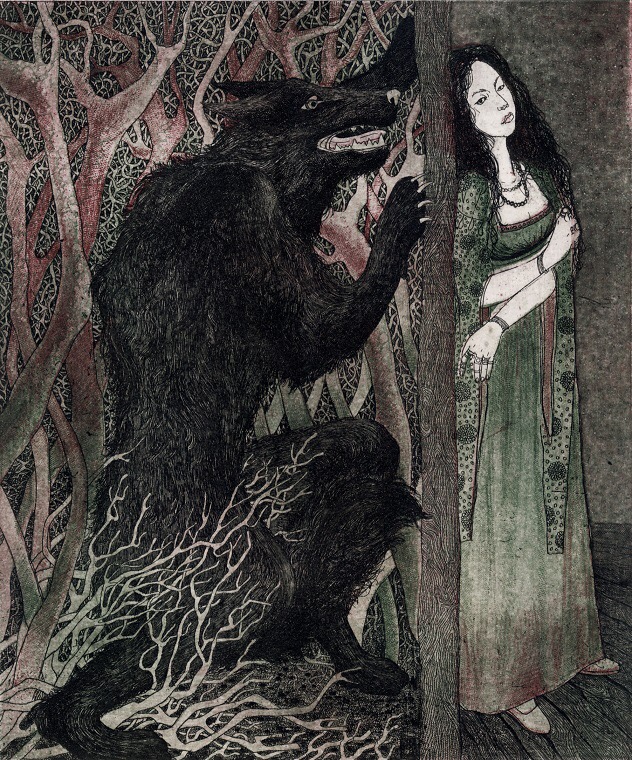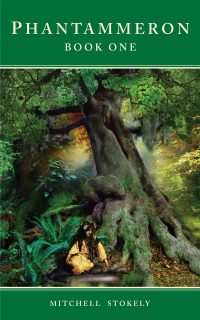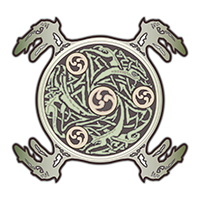In my fantasy novel, the Phantammeron, I have used many types of symbols to connect the story with what I call the “secret meaning” hidden inside my books. The use of the Black Rose is just one of many.

Often my use of roses and other symbols in my books is intentional, designed to mirror the light or dark of my characters, for example. Other times they are designed to portray events in a conflicting manner.
That goes back to my view that Celtic mythology and European fairy tale was often dualistic and tied to the constant movement of light and dark, winter and summer, and good and evil dualism in our ancient ancestors deeper cosmologies.
As a writer, I often try and tap into more modern myths, like that of the rose as a cultural symbol of love, marriage, and relationships in American people today. But that often isn’t relevant compared to myth. The black roses in my books are one of many attempts at portraying the larger conflict of darkness within love, something more powerful than modern tropes about relationships. In doing so I’m connecting with unconscious and primal symbols we don’t often recognize yet respond to in more primitive stories and modern fairy tales.
Too often story-tellers today use such dark ideas as proof Modern Man is inherently evil. And so such symbols get connected to the anti-hero who becomes a dark figure equally capable of violence and passionate love. That’s not the true purpose of these dark symbols, however. In fact dark symbols require we connect with the ancient mythology which portrayed the shadow-world as a place of spirits; the world of our ancestors, where violence and immorality was not celebrated through death but where such dark images became opposites to the living world.
To our western ancestors, dark symbols were part of an opposite world or parallel universe to our own. The ancients believed such underworlds were where the Sun God traveled, or where the spirits of our ancestors slept when they died, to be awakened on sacred sun celebrations like Halloween and Christmas. Dark Roses are a part of that conflicted mythological message.
In the Phantammeron, the Endless Night, a Primordial One, loses the great wars with his siblings and they in turn imprison his children far from him. As a dark beast he then searches the world for them until he stumbles upon the beautiful Secret Spring, a beautiful golden-haired maiden who sleeps in the heart of the Phantaian Forest. His love for the Secret Spring overcomes him. But seeing his horrible countenance, she flees from the Endless Night, leaving him rejected and alone in that beautiful place that would later become the Gardens of Abrea.
The Murgala in the Phantammeron

In my first novel I’ve enjoyed playing with a lot of different Western themes, Indo-European fairy tales, and mythological symbols. One idea I’m using in my Phantammeron novels is called the “Murgala”, or Black Roses. They are found in the garden of paradise called Abrea and created from the tears of the bat-winged character called the Endless Night.
It’s there he weeps for her and his tears form the Black Roses called the Murgala. The Endless Night’s tears were borne of his love for her. The roses then grow from his dark tears darkness, his Glourun, upon the slopes that lay beneath the One Tree and the Sacred Pool that would dwell there. And so the Murgala or Black Roses are not a symbol of evil but a symbol of forgotten love.
The Murgala thus encompass sadness and rejection yet unfulfilled love and hope of love. For black roses remain a symbol of the marriage of opposites; of dark and light powers which is but the nature of the world and its opposites.
That then becomes one of the secret meanings for the Murgala in my books. The black roses are simply born of normal Human emotions and struggle, and yet reflect something more. For later in the Phantammeron the reader learns the petals are used to lead the Endless Night’s child, the Shadow, to the garden. Yet they seem to drag along the fate of the garden and the story towards some other fate?
The mystery of such things is how and why I use them in story. For strong symbols like black roses in books must carry mythology, emotions, and yet something more. They must connect multiple meanings to plot and in some cases fate that shows how we are all trapped in a web of past and future events we often don’t see and yet cannot escape. And so the Murgala support my belief in fate and a life-direction uncontrolled by protagonists and their freer wills.
In the Phantammeron the black roses become a “leitmotif”; a minor storybook theme to connect the grander story to some meaning or symbolic purpose. The dark roses cause many strange things and appear when odd events occur. They prick Ana and almost poison her but Phanyan rescues her from their vines. The Murgala are blamed for the death of the child of the Secret Spring by the curse left there by the Endless Night that spawned them. Later the reader finds out she died willingly.
At times the Black Roses seem to have no “real” purpose in the book and do not seem to be a part of any resolution. That idea is a critical part of my cosmological philosophy…..that relics, rings, swords, flowers, and objects should never be the source of anything truly important in fantasy books. They should serve as a symbol or an event that connects readers to deeper meaning, not be THE meaning. For what are objects compared to the larger fate of your characters?
In the Phantammeron the reader learns that the witch Anissa uses their petals to form a trail through the forest to Abrea so the evil Shadow can find Ana. When the Shadow appears to slay Ana, the black roses suddenly sprout up around him as a symbol of his darkness and his connection to the Endless Night his father who made them. The Shadow then hands one of the dark blooms to her as a form of perverse love. And so their “secretive” nature starts to unfold. She naturally rejects it as did the Secret Spring. Connections and reflections like this are thus framed throughout the book through the Black Rose motif.
But the roses become just a part of something much more mysterious and meaningful…..a symbol of something larger in the reader I’m pulling out so seductively so that the roses are interpreted as something important. And yet the Murgala remain a part of something painful in us, an unfulfilled love, of regret, of revenge. They support the plot yet remain a Western archetype many readers will connect to because such dark things are a part of Western fairy tale and the darker archetypes buried in our minds. We “sense” a meaning in Black Roses, don’t we, but we cannot quite touch it. And so I love leaving those archetypes OPEN for the reader to interpret.
The use of symbols like this are really powerful in story for that reason. They extend BEYOND the book and affect us all apart from their story meaning. They don’t have to be tied to traditional fairy tale but can grow into something darker or richer inside us if you keep them mysterious and symbolically connected to larger meanings in our lives.
For symbols are lasting things and can show us a deeper aspects of the cosmos we are too fearful to see, like the fact there is no freewill but just the illusion of it. We are but surrounded by black roses waiting to be picked and which entrap is all in larger destinies we dare not believe in. For all around us grow the roses of our own success and doom, often picked by us before we choose.
Such is the meaning of strange things as roses and other dark symbols in my books I cherish long after I’ve written them.
– the Author
Created Feb 1, 2017, 5:28 PM



